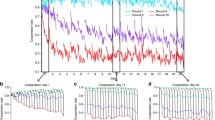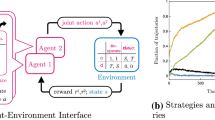Abstract
Our Pavlov learns by conditioned response, through rewards and punishments, to cooperate or defect. We analyze the behavior of an extended play Prisoner's Dilemma with Pavlov against various opponents and compute the time and cost to train Pavlov to cooperate. Among our results is that Pavlov and his clone would learn to cooperate more rapidly than if Pavlov played against the Tit for Tat strategy. This fact has implications for the evolution of cooperation.
Similar content being viewed by others
References
Axelrod, R.: 1984,The Evolution of Cooperation, Basic Books, New York.
Axelrod, R. and Hamilton, W. D.: 1981, ‘The Evolution of Cooperation’,Science 211, 1390–96.
Hofstadter, D. R.: 1983, ‘Computer Tournaments of the Prisoner's Dilemma’,Scientific American 248(5), 16–26.
Kemeny, J. G. and Snell, J. L.: 1976,Finite Markov Chains, Springer-Verlag, New York.
PC-MATLAB: 1985, 1987, The Math Works, 20 N. Main St., Suite 250, Sherborn, MA 01770.
Rapoport, A. and Chammah, A. M.: 1985,Prisoner's Dilemma, Univ. of Mich. Press, Ann Arbor.
Author information
Authors and Affiliations
Rights and permissions
About this article
Cite this article
Kraines, D., Kraines, V. Pavlov and the prisoner's dilemma. Theor Decis 26, 47–79 (1989). https://doi.org/10.1007/BF00134056
Issue Date:
DOI: https://doi.org/10.1007/BF00134056




